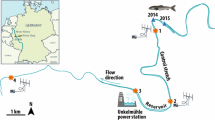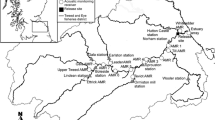Abstract
The fate of radio-tagged hatchery-reared salmon smolts (Salmo salar L.) was investigated in the tailrace of a hydropower station in the Danish River Gudenaa during 2 years. Seventeen and 27 smolts were tagged and released in late May 1996 and during April 1999, respectively. Out of the total of 44 smolts, only two were recorded to leave the river and enter the estuary. In both years of study, electrofishing was used to sample tagged smolts. In 1996, these attempts were unsuccessful, while in 1999, 19 (70% of total) transmitters were retrieved in the stomachs of pikeperch (Stizostedion lucioperca (L.)) and pike (Esox lucius L.), and in grey heron (Ardea cinerea L.) nests. The present study demonstrates that the physical condition of the watershed, with respect to spawning and rearing, may not be the only crucial determining factors of the success of reintroduction of Atlantic salmon. Hydropower plants not only block the free movement of migratory fish, hence preventing the utilisation of spawning and rearing areas, but also form the basis of areas with increased mortality.
Similar content being viewed by others
References
Aarestrup, K., C. Nielsen & S. S. Madsen, 2000. Relationship between gill Na+, K+-ATPase activity and downstream movement in domesticated and first-generation offspring of wild anadromous brown trout (Salmo trutta). Can. J. Fish. aquat. Sci. 57: 2086-2095.
Collis, K., R. E. Beaty & B. R. Crain, 1995. Changes in catch rate and diet of Northern squawfish associated with release of hatchery-reared juvenile salmonids in a Columbia River reservoir. N. Am. J. Fish. Manage. 15: 6-357.
Dahl, J., 1982. A century of pikeperch in Denmark. EIFAC Tech. Pap. 42 (Suppl. 2): 44-352.
Findlay, C. S., D. G. Bert & L. Zheng, 2000. Effect of introduced piscivores on native minnow communities in Adirondack lakes. Can. J. Fish. aquat. Sci. 57: 570-580.
Holdensgaard, G., C. Pedersen & S. Thomassen, 1997. Nedvandring af laksesmolt udsat som 1/2-årsfisk, 1-årsfisk og smolt, samt nedvandring af ørredsmolt i Gudenåen og Tange Sø 1994-1996. Rapport 2, 45 pp. (In Danish).
Holling, C. S., 1959. Some characteristics of simple type of predation and parasitism. Can. Entomol. 91: 384-398.
Holling, C. S., 1965. The functional response of predators to prey density and its role in mimicry and population regulation. Mem. entomol. Soc. Can. 45: 1-60.
Jepsen, N., 1999. Behaviour of lake piscivores and their predation on migrating smolts. Ph.D. dissertation. Environmental Engineering Laboratory, Aalborg University, 159 pp.
Jepsen, N., K. Aarestrup, F. Økland & G. Rasmussen, 1998. Survival of radiotagged Atlantic salmon (Salmo salar L.)-and trout (Salmo trutta L.) smolts passing a reservoir during seaward migration. Hydrobiologia 371/372: 347-353.
Koed, A., 2000. River dwelling piscivorous pikeperch Stizostedion lucioperca (L.): some biological characteristics and their ecological consequences. Ph.D. dissertation. University of Copenhagen, 191 pp.
Koed, A., P. Mejlhede, K. Balleby & K. Aarestrup, 2000. Annual movements and migration of adult pikeperch in a lowland river. J. Fish Biol. 57: 1266-1279.
Lowry, O. H., N. J. Rosebrough, A. L. Farr & R. J. Randall, 1951. Protein measurement with the folin phenol reagent. J. Biol. Chem. 193: 265-275.
McCleave, J. D. & K. A. Stred, 1975. Effect of dummy telemetry transmitters on stamina of Atlantic salmon (Salmo salar) smolts. J. Fish. Res. Bd. Can. 32: 559-563.
McCormick, S. D., 1993. Methods for non-lethal gill biopsy and measurement of gill Na+, K+-ATPase activity. Can. J. Fish. aquat. Sci. 50: 656-658.
Mellas, E. & J.M. Haynes, 1985. Swimming performance and behavior of rainbow trout (Salmo gairdneri) and white perch (Morone americane): effects of attaching telemetry transmitters. Can. J. Fish. aquat. Sci. 42: 488-493.
Mesa, M. G., T. P. Poe, D. M. Gadomski & J. H. Petersen, 1994. Are all prey created equal? A review and synthesis of differential predation on prey in substandard condition. J. Fish Biol. 45: 81-96.
Nielsen, C., G. Holdensgaard, H. C. Petersen, B. Th. Björnsson & S. S. Madsen, 2001. Genetic differences in physiology, growth hormone levels and migratory behaviour of Atlantic salmon smolts. J. Fish Biol. 59: 28-44.
Nielsen, J., 1983. Fiskene i Skanderborg Søerne. Skanderborg: Skanderborg Kommune, 118 pp. (In Danish, with figure and table captions in English).
Nielsen, J., 1997. Smoltvandringer hos laks (Salmo salar) og havørred (Salmo trutta) i vandløb og søer. Lyngby: Cowi., 39 pp. (In Danish).
Peake, S., F. W. H. Beamish, R. S. McKinley, D. A. Scruton & C. Katopodis, 1997. Relating swimming performance of lake sturgeon, Acipenser fluscens, to fishway design. Can. J. Fish. aquat. Sci. 54: 1361-1366.
Peterman, R. M. & M. Gatto, 1978. Estimation of functional responses of predators on juvenile salmon. J. Fish. Res. Bd Can. 35: 797-808.
Petersen, J. H., 1994. Importance of spatial pattern in estimating predation on juvenile salmonids in the Colombia River. Trans. am. Fish. Soc. 123: 924-930.
Poe, T. P., R. S. Shively & R. A. Tabor, 1994. Ecological consequences of introduced piscivorous fishes in the lower Columbia and Snake rivers. In Stouder, D. J., K. L. Fresh & R. J. Feller (eds), Theory and Application of Fish Feeding Ecology. The Belle W. Baruch Libary in Marine Science, University of South Carolina Press, Columbia, South Carolina 18: 347-360.
Rasmussen, G., K. Aarestrup & N. Jepsen, 1996. Mortality of sea trout (Salmo trutta L.) and Atlantic salmon (Salmo salar L.) smolts during seaward migration through rivers and lakes in Denmark. ICES Council Meeting papers. Copenhagen. 1996/T, 9 pp.
Rieman, B. E., R. C. Beamesderfer, S. Vigg & T. P. Poe, 1991. Estimated loss of juvenile salmonids to predation by northern squawfish, walleyes, and smallmouth bass in John Day Reservoir, Colombia River. Trans. am. Fish. Soc. 120: 448-458.
Rodgers, J. D., R. D. Ewing & J. D. Hall, 1987. Physiological changes during seaward migration of wild juvenile coho salmon (Oncorhynchus kisutch). Can. J. Fish. aquat. Sci. 44: 452-457.
Shively, R. S., T. P. Poe & S. Sauter, 1996. Feeding response by northern squawfish to a hatchery release of juvenile salmonids in the Clearwater River, Idaho. Trans. am. Fish. Soc. 125: 230-236.
Solomon, D. J. 1978. Some observations on salmon smolt migration in a chalkstream. J. Fish Biol. 12: 571-574.
Ward, D. L., J. H. Petersen & J. Loch, 1995. Index of predation on juvenile salmonids by northern squawfish in the lower and middle Columbia River and the lower Snake River. Trans. am. Fish. Soc. 124: 321-334.
Author information
Authors and Affiliations
Corresponding author
Rights and permissions
About this article
Cite this article
Koed, A., Jepsen, N., Aarestrup, K. et al. Initial mortality of radio-tagged Atlantic salmon (Salmo salar L.) smolts following release downstream of a hydropower station. Hydrobiologia 483, 31–37 (2002). https://doi.org/10.1023/A:1021390403703
Issue Date:
DOI: https://doi.org/10.1023/A:1021390403703




